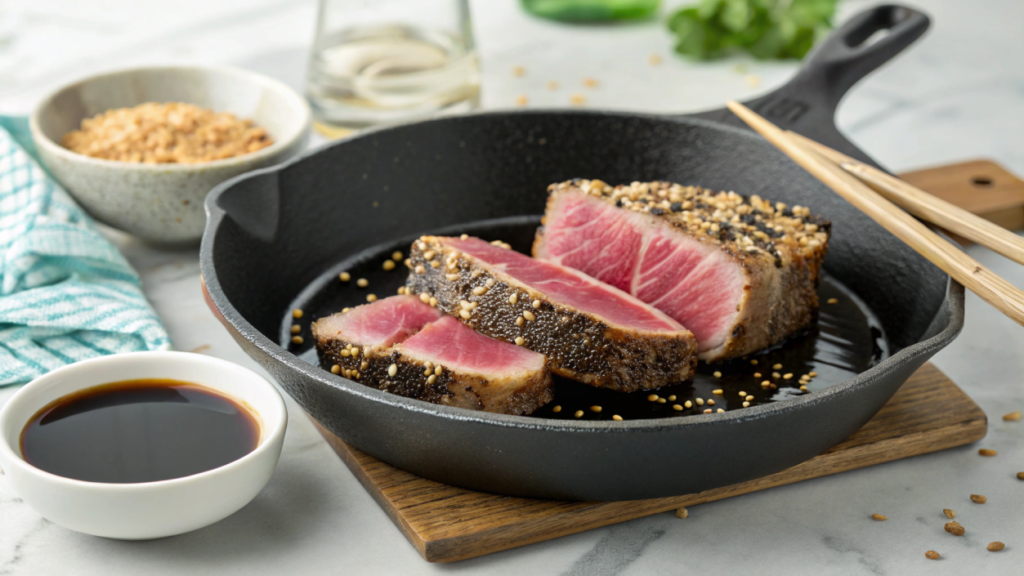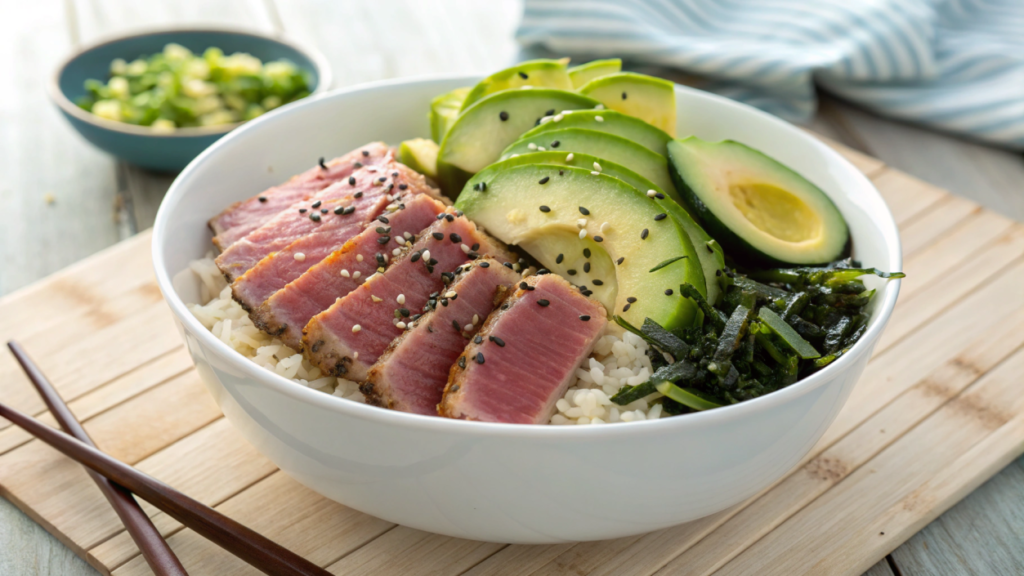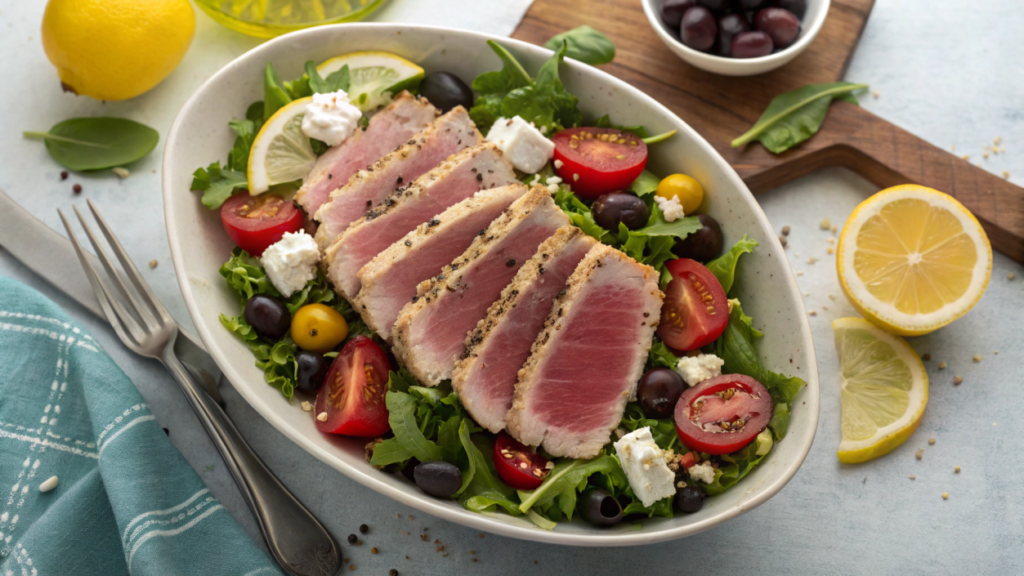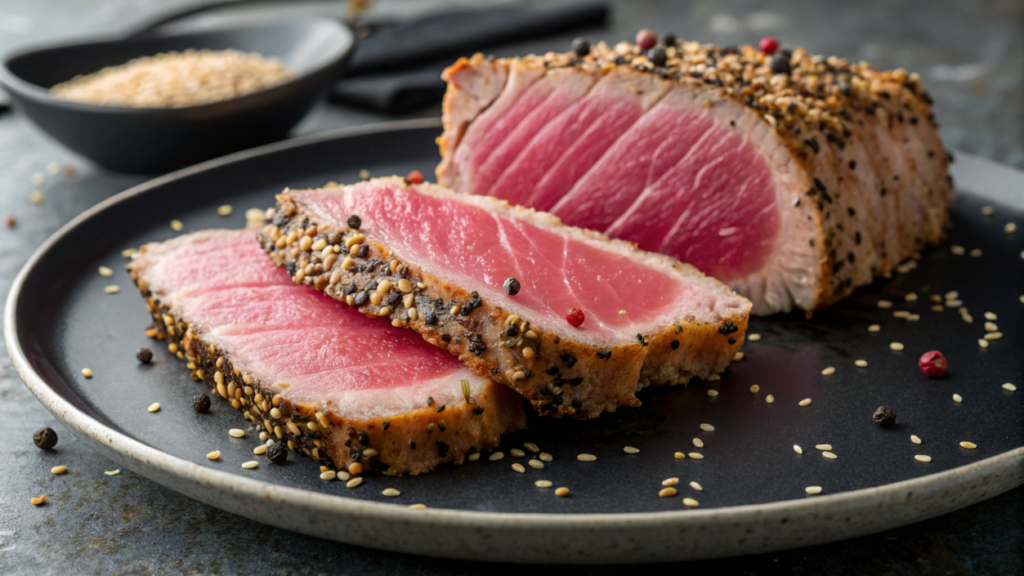Ahi Tuna Recipe Seare – Why This Recipe?
As Chef Greeny, I still remember the first time I prepared a perfectly seare ahi tuna steak. The vibrant pink center contrasted beautifully with the caramelized crust, creating a dish that was not only visually stunning but incredibly delicious. This experience sparked my passion for ahi tuna recipe seare techniques, leading me to experiment with various methods and flavors over the years.
Ahi tuna prepared with the seare method holds a special place in my culinary journey because it represents the perfect balance of simplicity and sophistication. It’s a dish that requires minimal cooking time yet delivers maximum flavor impact. What I love most about this preparation method is how it preserves the natural, buttery texture of the tuna while enhancing its flavor with a savory crust.
In this blog post, I’m excited to share my signature ahi tuna recipe seare to perfection, along with some unique twists that elevate this classic dish. You’ll learn not only how to achieve restaurant-quality results at home but also how to pair your ahi tuna with complementary flavors that will impress even the most discerning palates.
By the end of this guide, you’ll master the art of the seare technique for ahi tuna, understand the nutritional benefits of this lean protein, explore its rich cultural history, and discover creative variations to suit different dietary preferences. Let’s dive into the world of ahi tuna recipe seare and transform your seafood cooking game!
Ahi Tuna Recipe Seare – Ingredients and Preparation
Ingredients List

For the Perfect Ahi Tuna Recipe Seare (serves 4):
- 4 ahi tuna steaks (6-8 oz each), about 1-1.5 inches thick
- 2 tablespoons sesame oil
- 2 tablespoons soy sauce or tamari
- 1 tablespoon rice vinegar
- 1 teaspoon fresh ginger, grated
- 2 cloves garlic, minced
- 2 tablespoons sesame seeds (white, black, or mixed)
- 1 teaspoon kosher salt
- 1/2 teaspoon freshly ground black pepper
- 1 tablespoon neutral oil with high smoke point (avocado, grapeseed, or canola)
For the Wasabi-Soy Dipping Sauce:
- 3 tablespoons soy sauce or tamari
- 1 teaspoon wasabi paste (adjust to taste)
- 1 teaspoon rice vinegar
- 1/2 teaspoon honey or maple syrup
- 1 green onion, finely sliced
Substitution Options:
- Gluten-Free: Replace soy sauce with tamari or coconut aminos
- Soy-Free: Use coconut aminos instead of soy sauce
- Low-Sodium: Use reduced-sodium soy sauce and omit added salt
- Sesame Allergy: Replace sesame oil with olive oil and omit sesame seeds
Step-by-Step Instructions
- Prepare the tuna steaks
- Pat the tuna steaks dry with paper towels. This is crucial for achieving a perfect seare.
- Chef’s Tip: For best results, bring the tuna to room temperature for about 15-20 minutes before cooking.
- Make the marinade
- In a shallow dish, combine sesame oil, soy sauce, rice vinegar, grated ginger, and minced garlic.
- Chef’s Tip: Don’t marinate for more than 15 minutes, as the acid in the marinade can start to “cook” the fish.
- Season the tuna
- Remove the tuna from the marinade and pat dry again.
- In a small bowl, mix sesame seeds, salt, and pepper.
- Press the seasoning mixture onto all sides of the tuna steaks.
- Chef’s Tip: For an extra flavor boost, toast the sesame seeds in a dry pan until fragrant before using.
- Heat the pan
- Place a heavy-bottomed skillet (preferably cast iron) over high heat until it’s very hot.
- Add the high-smoke-point oil and swirl to coat the pan.
- Chef’s Tip: The pan should be smoking hot before adding the tuna. If it’s not hot enough, you won’t achieve that beautiful seare.
- Apply the seare technique
- Carefully place the tuna steaks in the hot pan.
- Seare for exactly 45 seconds to 1 minute per side for rare, or 1.5 minutes per side for medium-rare.
- Use tongs to briefly seare the edges, about 15 seconds per edge.
- Chef’s Tip: Time this step precisely! Overcooking will result in dry, tough tuna.
- Rest and slice
- Transfer the ahi tuna recipe seare result to a cutting board and let rest for 1-2 minutes.
- Using a very sharp knife, slice the tuna against the grain into 1/4-inch thick slices.
- Chef’s Tip: Wipe your knife with a damp cloth between slices for clean cuts.
- Prepare the dipping sauce
- While the tuna rests, whisk together all sauce ingredients.
- Serve alongside the sliced tuna.
Notes and Tips
Storage Tips:
- Ahi tuna recipe seare is best enjoyed immediately after cooking.
- If you have leftovers, store them in an airtight container in the refrigerator for up to 1 day.
- Do not reheat leftover tuna as it will become overcooked; instead, serve it cold in salads or poke bowls.
Serving Suggestions:
- Serve over a bed of mixed greens with a citrus vinaigrette
- Pair with sushi rice and pickled ginger for an elegant presentation
- Create a deconstructed poke bowl with avocado, cucumber, and seaweed salad
- Serve as an appetizer with the wasabi-soy dipping sauce
Make-Ahead Instructions:
- Prepare the marinade and dipping sauce up to 24 hours in advance.
- The actual seare technique should be done right before serving for optimal texture and flavor.
Ahi Tuna Recipe Seare – Nutritional Information

Nutrition Facts (Per Serving)
| Nutrient | Amount |
|---|---|
| Calories | 230 |
| Carbohydrates | 3g |
| Protein | 35g |
| Total Fat | 9g |
| Saturated Fat | 1.5g |
| Unsaturated Fat | 7g |
| Trans Fat | 0g |
| Fiber | 1g |
| Sugar | 1g |
| Cholesterol | 65mg |
| Sodium | 610mg |
Ahi tuna is not only delicious but also incredibly nutritious. It’s an excellent source of high-quality protein and contains heart-healthy omega-3 fatty acids. The minimal cooking involved in the seare method helps preserve these nutrients, making this preparation technique both flavorful and nutritionally beneficial.
When enjoying ahi tuna recipe seare, you’re also getting important minerals like selenium, magnesium, and potassium, as well as B vitamins including B12, which is essential for energy production and brain health.
For those monitoring their sodium intake, you can reduce the amount of soy sauce used in both the marinade and dipping sauce. The nutritional values above reflect the recipe as written.
Ahi Tuna Recipe Seare – History and Cultural Significance
Ahi tuna, also known as yellowfin tuna, has a rich cultural history that spans across many Pacific Island nations, Japan, and Hawaii. The word “ahi” comes from the Hawaiian language, where it refers to both yellowfin and bigeye tuna species.
In traditional Hawaiian cuisine, ahi was often consumed raw in dishes like poke, which has ancient roots as a fisherman’s food. The preparation involved cutting the fish into cubes and seasoning it with sea salt, seaweed, and crushed candlenuts. Modern poke has evolved but still showcases the natural flavor and texture of ahi tuna.
The technique of ahi tuna recipe seare while leaving the center rare is more contemporary and reflects the influence of Japanese culinary traditions on global cuisine. In Japan, tataki is a similar preparation method where fish or meat is seared on the outside and left rare in the middle, then thinly sliced. This technique highlights the quality and freshness of the fish – attributes highly valued in Japanese food culture.
The popularity of ahi tuna recipe seare in Western cuisine began to rise in the 1990s as part of the fusion food movement, where chefs combined elements from different culinary traditions. Today, this preparation method has become a staple on restaurant menus worldwide, appreciated for its delicate flavor, beautiful presentation, and nutritional benefits.
Regional variations of the seare technique for tuna can be found throughout the Pacific Rim:
- In Hawaii, it might be served with a pineapple salsa
- In Japan, it’s often accompanied by ponzu sauce and daikon radish
- In California cuisine, it might be paired with avocado and citrus
- In Mediterranean preparations, it could be served with olive tapenade and fresh herbs
Understanding the cultural significance of ahi tuna enhances our appreciation of this magnificent fish and the various ways it has been prepared and enjoyed across different cultures.
Ahi Tuna Recipe Seare – Creative Variations
1. Asian-Inspired Ahi Tuna Bowl
Transform your ahi tuna recipe seare into a satisfying meal with this Asian-inspired bowl. After preparing the tuna using the seare technique, serve it over steamed short-grain rice with:
- Sliced avocado
- Julienned cucumber
- Pickled ginger
- Shredded nori
- Edamame beans
- Sprinkle of furikake seasoning
Drizzle with a combination of soy sauce, rice vinegar, and a touch of honey for a balanced and nutritious meal that’s both satisfying and elegant.
2. Mediterranean Ahi Tuna Salad
For a lighter option with Mediterranean flair, prepare your ahi tuna recipe seare and serve it atop a bed of:
- Mixed baby greens
- Cherry tomatoes
- Kalamata olives
- Thinly sliced red onion
- Cucumber chunks
- Crumbled feta cheese
Dress with a simple lemon-olive oil vinaigrette enhanced with fresh herbs like oregano and basil. This variation is perfect for low-carb and keto diets, offering a refreshing alternative that still showcases the delicate flavor of the tuna.
3. Spicy Cajun Ahi Tuna Recipe Seare
For those who enjoy bolder flavors, try this Cajun-inspired variation:
- Replace the sesame seeds in the original recipe with a Cajun spice blend
- Increase the seare time slightly to 1 minute per side to complement the spice profile
- Serve with a cool avocado-lime crema to balance the heat
- Pair with dirty rice or corn maque choux for an authentic Southern-inspired meal
This variation introduces exciting new flavors while still maintaining the integrity of the ahi tuna’s natural taste and texture.
Ahi Tuna Recipe Seare – Frequently Asked Questions

How do I know if my ahi tuna is fresh enough for the seare technique?
Fresh ahi tuna should have a clean, ocean-like smell (not fishy), firm texture, and vibrant red or pink color. When purchasing, look for steaks that are moist but not slimy. For the best ahi tuna recipe seare results, buy from a reputable fishmonger and use the fish the same day if possible. If the tuna has any brown spots or discoloration, it’s not ideal for this preparation method.
Can I freeze ahi tuna before applying the seare technique?
While fresh is always best for ahi tuna recipe seare, you can freeze high-quality ahi tuna. If doing so, wrap it tightly in plastic wrap, then in foil, and place in a freezer bag with all air removed. Thaw in the refrigerator overnight before using. Keep in mind that previously frozen tuna may release more moisture during cooking, which can affect the quality of your seare.
What’s the difference between yellowfin and bigeye tuna for the seare method?
Both yellowfin (commonly called ahi) and bigeye tuna work well with the seare technique. Bigeye typically has a higher fat content, resulting in a richer flavor and more buttery texture. Yellowfin tends to be leaner but still provides excellent results. Either choice works wonderfully for ahi tuna recipe seare, though bigeye might be preferred by connoisseurs for its luxurious mouthfeel.
Is it safe to eat ahi tuna that’s rare in the center?
When using fresh, sushi-grade ahi tuna and proper handling techniques, eating tuna that’s rare in the center is generally considered safe and is actually preferred for the best texture and flavor. However, pregnant women, young children, elderly individuals, and those with compromised immune systems should fully cook their seafood to minimize any risk of foodborne illness.
What can I substitute for ahi tuna if it’s not available?
If ahi tuna isn’t available, other firm fish that work well with the seare technique include:
- Salmon (though it has a different flavor profile and higher fat content)
- Swordfish (cook slightly longer as it’s denser)
- Mahi-mahi (will need to be cooked through rather than rare)
- Tuna steaks from other species like albacore (though the texture won’t be identical)
Each alternative will provide a different experience, but the seare technique can still be applied effectively.
How long does it take to prepare ahi tuna recipe seare?
The entire process takes approximately 20-25 minutes:
- 5 minutes to prepare the marinade
- 10-15 minutes for marinating (optional but recommended)
- 5 minutes for heating the pan and cooking the tuna
- 2-3 minutes for resting and slicing
This quick preparation time makes ahi tuna recipe seare perfect for elegant weeknight dinners or impressive yet effortless entertaining.
Ahi Tuna Recipe Seare – Final Thoughts
Mastering the ahi tuna recipe seare technique opens up a world of culinary possibilities that combine elegance with simplicity. What makes this preparation method so special is its ability to highlight the natural qualities of the fish while adding just enough flavor enhancement to create a memorable dining experience.
Throughout this guide, we’ve explored not only the fundamental techniques for achieving the perfect seare but also the rich cultural context that has shaped how we enjoy ahi tuna today. From its Hawaiian origins to its place in contemporary global cuisine, ahi tuna continues to captivate food enthusiasts with its versatility and nutritional benefits.
Whether you follow the classic preparation or experiment with one of the creative variations, the key to success lies in respecting the quality of your ingredients and paying careful attention to cooking times. The difference between perfectly seare ahi tuna and an overcooked disappointment often comes down to just a matter of seconds.
I encourage you to try this ahi tuna recipe seare technique at home and make it your own. Perhaps you’ll develop a signature spice blend or a unique sauce that complements the delicate flavor of the fish. The possibilities are endless, and the rewards are delicious.
Have you tried preparing ahi tuna using the seare method before? What are your favorite accompaniments or variations? Leave a comment below sharing your experiences or asking any questions you might have about perfecting your ahi tuna recipe seare technique. I’d love to hear from you and continue this culinary conversation!
Learn more about different tuna species and sustainable fishing practices





7 thoughts on “Ahi Tuna Recipe Seare: 7 Delicious Ways to Perfect Your Seafood Experience”